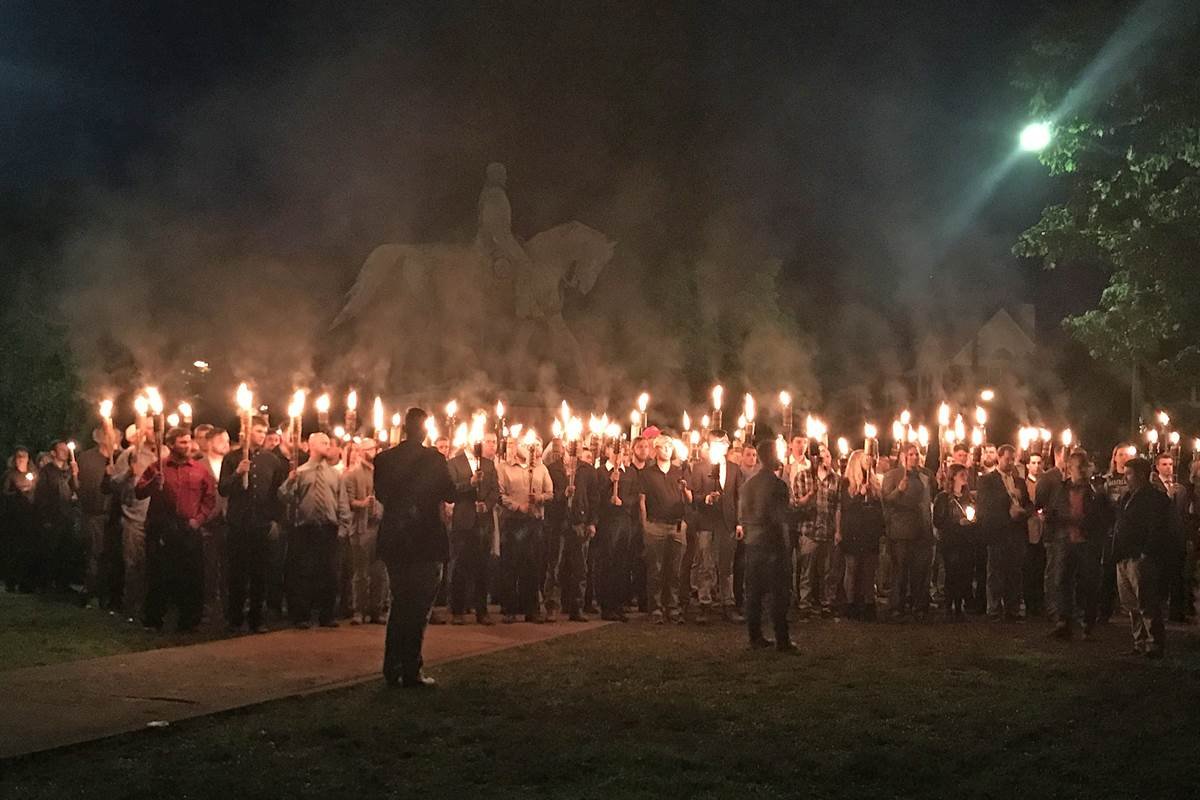On Friday night, August 11, in Charlottesville, multiple hundreds of white supremacists from a mélange of organizations marched virtually undisturbed across the campus of the University of Virginia in a well-ordered torchlight parade. They chanted, “You will not Replace Us,” and similar mantras. They did not scream White Power! like they usually do at Klan and neo-Nazi rallies. Boston—born Richard Spencer, 39 years old, the white nationalist who had emerged as the leader of this event, claimed in a YouTube interview that the parade was like a religious experience. Like many participants, he was thrilled at its success.
Richard Spencer During Friday Night Torchlight March.
The next day, Saturday, Spencer’s marchers, joined by hundreds more white supremacists, attempted to stage a rally near the statue of Robert E. Lee in the city’s newly-named Emancipation Park. They were blocked by thousands of anti-racist counter-protesters, including a contingent of clergy that ensured no racist would pass. When fighting, clubbing, and skirmishes began between the two opposing camps, Virginia Governor Terry McAuliffe declared an emergency and sent in National Guard troops to shut down everything. Around 1:40 P.M., a car drove directly into a congregation of counter protesters gathered on one of the side streets. One person, Heather Heyer, was murdered, another number were wounded.
 Heather Heyer Gave Her Life Standing Against White Nationalism
Heather Heyer Gave Her Life Standing Against White Nationalism
James Alex Fields Jr., who was photographed earlier holding a white nationalist shield, was arrested later in the day as the driver.
 James Alex Fields Jr. at the Unite the Right Rally
James Alex Fields Jr. at the Unite the Right Rally
More, the white-ists that day included a contingent of uniformed, weapons carrying militiamen (and a few women), unencumbered by protestors at the time a photo was shot.
Heavily-armed far-right paramilitaries marching during the Unite the Right rally.
It would seem that on this day, white-ists had failed to hold a rally, had killed one and injured many, and failed miserably. Nevertheless, they walked off with the conclusion that they had achieved a great victory.
What happened? Well, a qualitative change in the white nationalist movement had occurred, and the racists knew it. Membership growth during the past two years had significantly increased, bringing in a new generation of young activists. A new generation of leaders had become ensconced, replacing the so-called Baby Boomers. Raised after the collapse of the Cold War, and educated at universities, they could not live with the growing presence and apparent power of people of color. Although they embraced the white identity politics espoused by Richard Spencer, they concluded that their true goal was the creation of an all-white nation-state carved out of the multiracial United States: white nationalism. So there is no ideological difference between generations.
The immediate result of this qualitative change: increased racist activism and increasing challenges for anti-racists to build a successful community-based effort to push the white supremacists back.
Some observers believe that the growth in white supremacy is a direct result of the election of President Donald Trump. They cite the White House power of Steve Bannon, an avowed Alt-right advocate. And there are others like him peppered through the administration. Trump’s anti-immigrant policies, his verbal racism and bigotry, and his inability to unequivocally condemn the white supremacist’s violence in Charlottesville have also been cited. Indeed, as Virginia Attorney General Mark Herring put it, “The violence, chaos and apparent loss of life in Charlottesville is not the fault of “many sides.” It is racists and white supremacists.”
The violence, chaos, and apparent loss of life in Charlottesville is not the fault of “many sides.” It is racists and white supremacists.
— Mark Herring (@MarkHerringVA) August 12, 2017
All of these facts are unchallengeable. Plus, there is more. But the mistake is to conclude that Trump caused the white supremacist growth. Rather, it is IREHR’s analysis that Trump is the result, not the cause. Further, the national socialists among the white supremacists, and there are many, are ultimately opposed to Trump’s “dollar is supreme” version of capitalism. Further, many of them consider themselves environmentalists. While the appreciate Trump’s support, they oppose his coastline-eating policies.
There have been other qualitative leaps by white supremacists in the past four decades. In the aftermath of a Klan and neo-Nazi armed attack on anti-Klan protesters that left five dead and many wounded in Greensboro, North Carolina in November 1979, and the subsequent failure to convict any of the killers, the active white supremacist crowd grew by leaps and bounds in that state. Within a couple of years, the armed and dangerous White Patriot Party was one thousand strong in that state. Much murder and mayhem later, the white-ists were curbed by intense organizing by the North Carolinians Against Racist and Religious Violence, and ultimately by a Southern Poverty Law Center lawsuit.
As I spelled out in my 2009 book, Blood and Politics: The History of the White Nationalist Movement from the Margins to the Mainstream (available from IREHR), another leap occurred after 400 racists, led by two Klan factions, stopped a small inter-racial “brotherhood” march in Forsyth County in 1987. Many Klan rallies stomped across North Georgia in the aftermath. And David Duke was brought out of semi-retirement and two years later was elected to the Louisiana state assembly.
Now, it is anti-racists that stand at the crossroads. Will they take the time to study the situation? Can they meet the new white nationalist onslaught with a full-throated, creative response? Will they organize the unorganized white people to stand with them against the bigots? Can they build the multi-issue, multi-constituency coalitions that can grow and meet the challenges of the day? IREHR plans to do our part. Please do yours.





